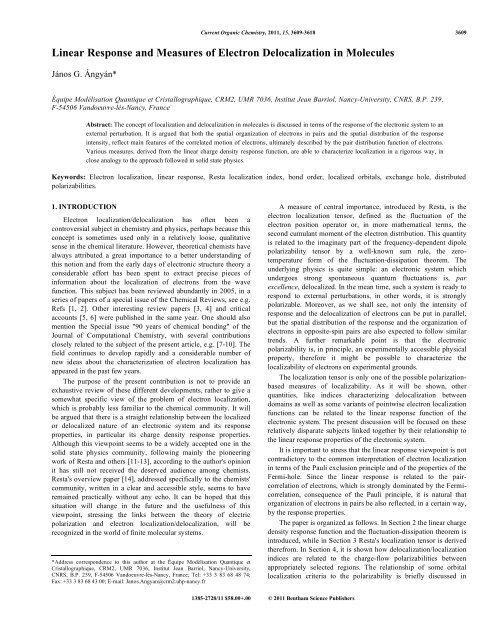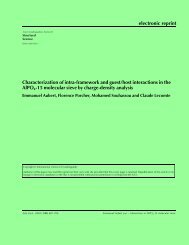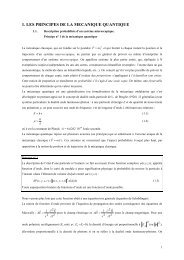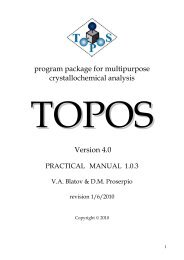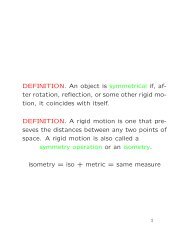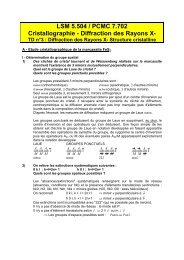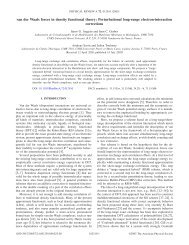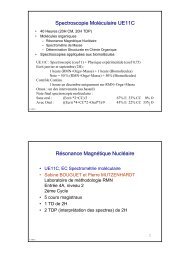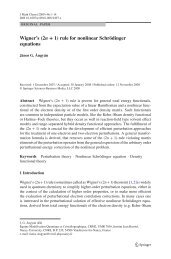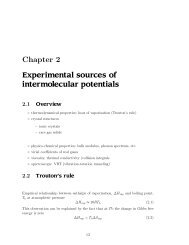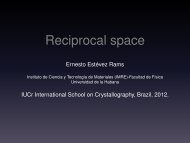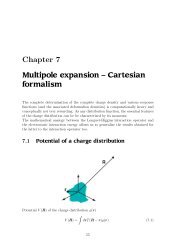Linear Response and Measures of Electron Delocalization ... - CRM2
Linear Response and Measures of Electron Delocalization ... - CRM2
Linear Response and Measures of Electron Delocalization ... - CRM2
Create successful ePaper yourself
Turn your PDF publications into a flip-book with our unique Google optimized e-Paper software.
Current Organic Chemistry, 2011, 15, 3609-3618 3609<br />
<strong>Linear</strong> <strong>Response</strong> <strong>and</strong> <strong>Measures</strong> <strong>of</strong> <strong>Electron</strong> <strong>Delocalization</strong> in Molecules<br />
János G. Ángyán*<br />
Équipe Modélisation Quantique et Cristallographique, <strong>CRM2</strong>, UMR 7036, Institut Jean Barriol, Nancy-University, CNRS, B.P. 239,<br />
F-54506 V<strong>and</strong>oeuvre-lès-Nancy, France<br />
Abstract: The concept <strong>of</strong> localization <strong>and</strong> delocalization in molecules is discussed in terms <strong>of</strong> the response <strong>of</strong> the electronic system to an<br />
external perturbation. It is argued that both the spatial organization <strong>of</strong> electrons in pairs <strong>and</strong> the spatial distribution <strong>of</strong> the response<br />
intensity, reflect main features <strong>of</strong> the correlated motion <strong>of</strong> electrons, ultimately described by the pair distribution function <strong>of</strong> electrons.<br />
Various measures, derived from the linear charge density response function, are able to characterize localization in a rigorous way, in<br />
close analogy to the approach followed in solid state physics.<br />
Keywords: <strong>Electron</strong> localization, linear response, Resta localization index, bond order, localized orbitals, exchange hole, distributed<br />
polarizabilities.<br />
1. INTRODUCTION<br />
<strong>Electron</strong> localization/delocalization has <strong>of</strong>ten been a<br />
controversial subject in chemistry <strong>and</strong> physics, perhaps because this<br />
concept is sometimes used only in a relatively loose, qualitative<br />
sense in the chemical literature. However, theoretical chemists have<br />
always attributed a great importance to a better underst<strong>and</strong>ing <strong>of</strong><br />
this notion <strong>and</strong> from the early days <strong>of</strong> electronic structure theory a<br />
considerable effort has been spent to extract precise pieces <strong>of</strong><br />
information about the localization <strong>of</strong> electrons from the wave<br />
function. This subject has been reviewed abundantly in 2005, in a<br />
series <strong>of</strong> papers <strong>of</strong> a special issue <strong>of</strong> the Chemical Reviews, see e.g.<br />
Refs [1, 2]. Other interesting review papers [3, 4] <strong>and</strong> critical<br />
accounts [5, 6] were published in the same year. One should also<br />
mention the Special issue "90 years <strong>of</strong> chemical bonding" <strong>of</strong> the<br />
Journal <strong>of</strong> Computational Chemistry, with several contributions<br />
closely related to the subject <strong>of</strong> the present article, e.g. [7-10]. The<br />
field continues to develop rapidly <strong>and</strong> a considerable number <strong>of</strong><br />
new ideas about the characterization <strong>of</strong> electron localization has<br />
appeared in the past few years.<br />
The purpose <strong>of</strong> the present contribution is not to provide an<br />
exhaustive review <strong>of</strong> these different developments, rather to give a<br />
somewhat specific view <strong>of</strong> the problem <strong>of</strong> electron localization,<br />
which is probably less familiar to the chemical community. It will<br />
be argued that there is a straight relationship between the localized<br />
or delocalized nature <strong>of</strong> an electronic system <strong>and</strong> its response<br />
properties, in particular its charge density response properties.<br />
Although this viewpoint seems to be a widely accepted one in the<br />
solid state physics community, following mainly the pioneering<br />
work <strong>of</strong> Resta <strong>and</strong> others [11-13], according to the author's opinion<br />
it has still not received the deserved audience among chemists.<br />
Resta's overview paper [14], addressed specifically to the chemists'<br />
community, written in a clear <strong>and</strong> accessible style, seems to have<br />
remained practically without any echo. It can be hoped that this<br />
situation will change in the future <strong>and</strong> the usefulness <strong>of</strong> this<br />
viewpoint, stressing the links between the theory <strong>of</strong> electric<br />
polarization <strong>and</strong> electron localization/delocalization, will be<br />
recognized in the world <strong>of</strong> finite molecular systems.<br />
*Address correspondence to this author at the Équipe Modélisation Quantique et<br />
Cristallographique, <strong>CRM2</strong>, UMR 7036, Institut Jean Barriol, Nancy-University,<br />
CNRS, B.P. 239, F-54506 V<strong>and</strong>oeuvre-lès-Nancy, France; Tel: +33 3 83 68 48 74;<br />
Fax: +33 3 83 68 43 00; E-mail: Janos.Angyan@crm2.uhp-nancy.fr<br />
A measure <strong>of</strong> central importance, introduced by Resta, is the<br />
electron localization tensor, defined as the fluctuation <strong>of</strong> the<br />
electron position operator or, in more mathematical terms, the<br />
second cumulant moment <strong>of</strong> the electron distribution. This quantity<br />
is related to the imaginary part <strong>of</strong> the frequency-dependent dipole<br />
polarizability tensor by a well-known sum rule, the zerotemperature<br />
form <strong>of</strong> the fluctuation-dissipation theorem. The<br />
underlying physics is quite simple: an electronic system which<br />
undergoes strong spontaneous quantum fluctuations is, par<br />
excellence, delocalized. In the mean time, such a system is ready to<br />
respond to external perturbations, in other words, it is strongly<br />
polarizable. Moreover, as we shall see, not only the intensity <strong>of</strong><br />
response <strong>and</strong> the delocalization <strong>of</strong> electrons can be put in parallel,<br />
but the spatial distribution <strong>of</strong> the response <strong>and</strong> the organization <strong>of</strong><br />
electrons in opposite-spin pairs are also expected to follow similar<br />
trends. A further remarkable point is that the electronic<br />
polarizability is, in principle, an experimentally accessible physical<br />
property, therefore it might be possible to characterize the<br />
localizability <strong>of</strong> electrons on experimental grounds.<br />
The localization tensor is only one <strong>of</strong> the possible polarizationbased<br />
measures <strong>of</strong> localizability. As it will be shown, other<br />
quantities, like indices characterizing delocalization between<br />
domains as well as some variants <strong>of</strong> pointwise electron localization<br />
functions can be related to the linear response function <strong>of</strong> the<br />
electronic system. The present discussion will be focused on these<br />
relatively disparate subjects linked together by their relationship to<br />
the linear response properties <strong>of</strong> the electronic system.<br />
It is important to stress that the linear response viewpoint is not<br />
contradictory to the common interpretation <strong>of</strong> electron localization<br />
in terms <strong>of</strong> the Pauli exclusion principle <strong>and</strong> <strong>of</strong> the properties <strong>of</strong> the<br />
Fermi-hole. Since the linear response is related to the paircorrelation<br />
<strong>of</strong> electrons, which is strongly dominated by the Fermicorrelation,<br />
consequence <strong>of</strong> the Pauli principle, it is natural that<br />
organization <strong>of</strong> electrons in pairs be also reflected, in a certain way,<br />
by the response properties.<br />
The paper is organized as follows. In Section 2 the linear charge<br />
density response function <strong>and</strong> the fluctuation-dissipation theorem is<br />
introduced, while in Section 3 Resta's localization tensor is derived<br />
therefrom. In Section 4, it is shown how delocalization/localization<br />
indices are related to the charge-flow polarizabilities between<br />
appropriately selected regions. The relationship <strong>of</strong> some orbital<br />
localization criteria to the polarizability is briefly discussed in<br />
1385-2728/11 $58.00+.00 © 2011 Bentham Science Publishers
3610 Current Organic Chemistry, 2011, Vol. 15, No. 20 János G. Ángyán<br />
Section 5. In Section 6, the local measures <strong>of</strong> the electron<br />
localization are overviewed from the polarizability viewpoint, <strong>and</strong><br />
finally we conclude by summarizing the main points <strong>of</strong> the present<br />
contribution.<br />
2. FROM THE POLARIZABILITY TO THE EXCHANGE-<br />
CORRELATION HOLE<br />
The response <strong>of</strong> an electronic system to an external, possible<br />
time-dependent, electric perturbation is characterized by a linear<br />
response function, (r, r ;) , which can be regarded as a<br />
generalization <strong>of</strong> its polarizability:<br />
(r;)= dr(r, r ;)V( r ;), . (1)<br />
where V( r ;) is a perturbing potential at point r oscillating by a<br />
frequency , (r;) is the induced charge density at r <strong>and</strong> the<br />
linear charge density response function is defined as<br />
(r,r ' ;)= lim 1<br />
0 + n0<br />
<br />
0| ˆ(r)|nn | ˆ(r' )|0<br />
<br />
+ i 0n<br />
0| ˆ(r' )|nn | ˆ(r)|0<br />
i + 0n<br />
<br />
<br />
. (2)<br />
The zero-temperature fluctuation-dissipation theorem<br />
establishes a relationship between the imaginary part <strong>of</strong> the charge<br />
density response function <strong>and</strong> the charge density fluctuation<br />
autocorrelation function:<br />
<br />
<br />
d m(r, r ;)=S(r, r ). (3)<br />
0<br />
The charge density autocorrelation function, sometimes called<br />
static form factor, is a ground state expectation value,<br />
S(r, r )=0| ˆ(r) r )|0, (4)<br />
where ˆ(r)= ˆ(r)(r) is the charge density fluctuation operator<br />
taken with respect to the mean ground state density, (r) . The<br />
function S(r, r ) is closely related to the exchange-correlation hole,<br />
h xc<br />
(r, r )= 2<br />
(r, r )/(r)( r ) :<br />
S(r, r )=(r)h xc<br />
(r, r )+ (r)(r r ), (5)<br />
as it can be easily proven by considering the definition <strong>of</strong> the pair<br />
density operator, ˆ 2<br />
(r, r )= ˆ(r) ˆ( r )ˆ(r)(r r ) , <strong>and</strong> inserting it in<br />
the definition <strong>of</strong> the form factor.<br />
An approximate relationship can be established between the xchole<br />
density <strong>and</strong> the static charge density response,<br />
(r, r )=(r, r ;0). Let us define a position dependent parameter<br />
(r, r ) such that<br />
(r, r )= 2 <br />
S(r, r )<br />
(r, r ) . (6)<br />
(r, r ) plays the role <strong>of</strong> an average energy denominator for a pair<br />
<strong>of</strong> coordinates <strong>and</strong> allows us to express the frequency dependent<br />
polarizability in a single-pole form, c.f. Eq. (7) <strong>of</strong> Ref. [15]. If one<br />
neglects the spatial dependence <strong>of</strong> (r, r ) by replacing it by a<br />
space average, (r, r ) , an approximate proportionality can be<br />
established between the static polarizability <strong>and</strong> the xc-hole density:<br />
(r, r ) (r)h xc<br />
(r, r )+ (r)(r r ). (7)<br />
The qualitative meaning <strong>of</strong> the above relationship is that in a<br />
point r the amplitude <strong>of</strong> the electronic charge density response to<br />
an external perturbation at r can be predicted from the knowledge<br />
<strong>of</strong> the exchange-correlation hole belonging to the reference point<br />
r . The expected response will be different from zero only in those<br />
points <strong>of</strong> the space where the xc-hole is non-vanishing. In other<br />
words the polarization <strong>of</strong> the electrons remains confined within the<br />
space occupied by the xc-hole. If the xc-hole extends over the<br />
whole molecular framework, the electron is strongly delocalized.<br />
This would be a finite, molecular analog <strong>of</strong> the conducting state in<br />
an infinite solid. On the contrary, if the xc-hole occupies only a<br />
limited portion <strong>of</strong> the molecular space, one should consider the<br />
electron as localized. Therefore, as far as one underst<strong>and</strong>s the<br />
spatial distribution <strong>of</strong> the xc-hole, one has a key to predict the<br />
charge density response <strong>and</strong> vice versa. Both <strong>of</strong> these quantities,<br />
response function <strong>and</strong> Fermi-hole, provide appropriate bases for our<br />
underst<strong>and</strong>ing <strong>of</strong> electron localization.<br />
A related example for using a mapping between response<br />
functions <strong>and</strong> the Fermi-hole density has been given by the<br />
interpretation <strong>of</strong> the <strong>of</strong> Fermi-contact contributions to the nuclear<br />
spin-spin coupling constants [16-19]. Visualization <strong>of</strong> the response<br />
spin densities <strong>and</strong> <strong>of</strong> the Fermi-hole belonging to a reference<br />
electron placed at an atomic position has convincingly<br />
demonstrated the relationship between these two quantities.<br />
Furthermore, a proportionality has been found between the spinspin<br />
coupling constants <strong>and</strong> the delocalization index between the<br />
atom pair, measuring the sharing <strong>of</strong> the Fermi-hole between the<br />
atomic volumes [16].<br />
The charge density polarizability function as well as the xc-hole<br />
are complicated two-variable functions, which are not really<br />
appropriate to obtain a quick insight <strong>and</strong> underst<strong>and</strong>ing. Further<br />
analysis <strong>of</strong> these functions is needed either in terms <strong>of</strong> integrated<br />
quantities or by using a kind <strong>of</strong> coarse-grain representation, e.g. by<br />
space domains or other kind <strong>of</strong> partitions <strong>of</strong> the molecule. In the<br />
following sections it will be shown how these functions are related<br />
to various simpler measures <strong>of</strong> electron localizability.<br />
3. RESTA LOCALIZATION TENSOR<br />
A useful global measure <strong>of</strong> the electron localizability has been<br />
defined by Resta [12-14], via the second cumulant moment <strong>of</strong> the<br />
electron distribution. It can be easily shown that the following<br />
expectation value, describing the electron position fluctuation per<br />
electron,<br />
N<br />
ˆr ˆr <br />
c<br />
= 1 N {0| ˆr <br />
(i)ˆr <br />
( j)|00| ˆr <br />
(i)|00| ˆr <br />
( j)|0}, (8)<br />
i, j=1<br />
i=1<br />
j=1<br />
is strictly equivalent to the second moment <strong>of</strong> the static form factor<br />
normalized to the number <strong>of</strong> electrons, N :<br />
N<br />
ˆr ˆr <br />
c<br />
= 1 '<br />
drdrr <br />
r <br />
S(r, r ). (9)<br />
N<br />
In the above equations ˆr <br />
(i) the = x, y,z component <strong>of</strong> the<br />
i -th electronic position vector. We can see that Eq. (9) establishes<br />
a direct link between fundamental two-variable functions discussed<br />
in the preceding section. The intensive quantity, ˆr ˆr <br />
c<br />
, is called<br />
also second cumulant moment per electron, or localization tensor<br />
[14].<br />
An explicitly origin-independent equivalent form <strong>of</strong> the<br />
localization tensor can be obtained by using the chargeconservation<br />
sum rule <strong>of</strong> the form factor:<br />
ˆr ˆr <br />
c<br />
= 1 dr dr (r r ) <br />
(r r') <br />
S(r, r ), (10)<br />
2N<br />
N
<strong>Linear</strong> <strong>Response</strong> <strong>and</strong> <strong>Measures</strong> <strong>of</strong> <strong>Electron</strong> <strong>Delocalization</strong> Current Organic Chemistry, 2011, Vol. 15, No. 20 3611<br />
Table 1. Selected "Experimental" Resta Localization Indices, r 2 exp c<br />
= 3 S DODS 2 N 1<br />
, from DOSD Data. The Systems are Listed in the Order <strong>of</strong> Increasing<br />
Localization Index. The Degree <strong>of</strong> <strong>Delocalization</strong>, as Measured by this Quantity, is Supposed to Increase from the the Top to the Bottom <strong>of</strong><br />
the Table<br />
Molecule<br />
r 2 c<br />
exp<br />
Ref. Molecule r 2 c<br />
exp<br />
Ref.<br />
Ne 0.5702 [22] H 2CO 1.1766 [21]<br />
SF 6 0.6739 [23] SiH 4 1.3233 [24]<br />
SiF 4 0.6951 [25] CH 3OCH 3 1.3321 [26]<br />
Ar 0.7307 [22] C 2H 5OC 2H 5 1.3900 [26]<br />
Cl 2 0.8523 [27] CH 3OC 3H 7 1.3975 [26]<br />
N 2 1.0161 [28] NH 3 1.3978 [28]<br />
CO 1.0422 [29] C 2H 2 1.4357 [30]<br />
H 2S 1.0942 [25] C 2H 4 1.5290 [31]<br />
H 2O 1.0974 [29] C 2H6 1.5625 [31]<br />
He 1.1168 [21] H 2 2.3250 [28]<br />
<strong>and</strong> Eq. (10) can be further transformed to a form, which is easy to<br />
interpret as the density-weighted second moment <strong>of</strong> the xc-hole<br />
function:<br />
ˆr ˆr <br />
c<br />
= 1 dr(r)dr (r r ) <br />
(r r') <br />
h xc<br />
(r, r ), (11)<br />
2N<br />
establishing a relationship between the xc-hole (dominated by the<br />
exchange- or Fermi-hole) <strong>and</strong> the Resta localization tensor. Clearly,<br />
<strong>and</strong> xc-hole with large second moment components can be<br />
considered as an indication for the presence <strong>of</strong> strongly delocalized<br />
electrons.<br />
The expression <strong>of</strong> the second cumulant moment in terms <strong>of</strong> the<br />
frequency-dependent dipole polarizability tensor, <br />
, is<br />
essentially the same as that <strong>of</strong> the S 1<br />
, the –1 order dipole oscillator<br />
strength sum rule (see e.g. Ref. [20]). Comparing<br />
<br />
dm<br />
<br />
0 <br />
()=N r <br />
r <br />
c<br />
(12)<br />
with the usual form <strong>of</strong> the sum rule, one finds a simple<br />
proportionality between dipole oscillator strength sum rule S 1<br />
<strong>and</strong><br />
the trace <strong>of</strong> the localization tensor, which can be called Resta<br />
localization index, r 2 c<br />
: r 2 c<br />
= 3<br />
2N S 1<br />
. Thus it can be expected<br />
that the spherical average <strong>of</strong> the localization tensor is an<br />
information accessible from experimental data, e.g. via the dipole<br />
oscillator strength distributions (DOSD) reported in the literature.<br />
The existence <strong>of</strong> such a relationship is quite remarkable, because it<br />
makes possible an experimental characterization <strong>of</strong> a fundamentally<br />
conceptual quantity, the electron localizability. A set <strong>of</strong> illustrative<br />
examples is presented in Table 1, partly relying on a compilation <strong>of</strong><br />
experimental data by Olney [21] <strong>and</strong> using also some more recent<br />
DOSD determinations.<br />
The S 1<br />
oscillator strength sum rule, <strong>and</strong> therefore the trace <strong>of</strong><br />
the localization tensor, is connected to the second moment <strong>of</strong> the<br />
intracule <strong>and</strong> extracule densities by rigorous relationships, which<br />
has been derived for the case <strong>of</strong> many-electron atoms [32]. It can be<br />
shown also that S 1<br />
(<strong>and</strong> the trace <strong>of</strong> the localization tensor) is<br />
proportional to the the negative <strong>of</strong> the mean squared distance<br />
between electrons.<br />
The Resta localization index, in a somewhat paradoxical<br />
manner, increases with the degree <strong>of</strong> delocalization. In view <strong>of</strong> this<br />
fact, it may seem legitimate to call this quantity rather<br />
"delocalization index". Alternatively one might choose e.g. the<br />
inverse <strong>of</strong> r 2 c<br />
, which would increase by increasing degree <strong>of</strong><br />
localization <strong>of</strong> the electron. However, such a change <strong>of</strong><br />
nomenclature would lead to confusion with earlier works, therefore<br />
the original terminology has been retained in this work.<br />
The discussion up to now has been about the in principle exact<br />
xc-hole, which supposes that both the ground state wave function in<br />
the expectation values <strong>and</strong> the linear response function appearing in<br />
the fluctuation-dissipation theorem are exact. Usually one has only<br />
some approximations available for these quantities, e.g. in the form<br />
<strong>of</strong> an independent particle method, like Hartree-Fock (HF) or<br />
Kohn-Sham (KS). In these cases, the single determinant wave<br />
function provides the exchange (Fermi) hole, which can be<br />
calculated from the first order density matrix. In principle, the same<br />
quantity can be obtained from the fluctuation-dissipation formula,<br />
using the the non-interacting (uncoupled Hartree-Fock, UCHF)<br />
response function. To reproduce expectation value results in this<br />
way, extremely large basis sets would be needed due to the slow<br />
convergence <strong>of</strong> the resolution <strong>of</strong> identity in Gaussian basis sets. A<br />
further possibility is to use the interacting, TDCHF (time-dependent<br />
coupled Hartree-Fock) polarizabilities in the fluctuation-dissipation<br />
formula, giving access to a low-order approximation <strong>of</strong> the<br />
correlation hole, but the problem <strong>of</strong> the basis set incompleteness<br />
remains still a crucial one. As far as direct correlation effects on the<br />
expectation value <strong>of</strong> the second cumulant moment are concerned, a<br />
few recent full CI calculations have been reported for linear Li n <strong>and</strong><br />
Be n chains in order to monitor the appearance <strong>of</strong> a metal-insulator<br />
type phase transitions as a function <strong>of</strong> the interatomic spacings<br />
[33, 34].<br />
The localization tensor itself can be related to the dynamic<br />
dipole polarizability tensor <strong>and</strong> it is approximately proportional to<br />
the static polarizability tensor <strong>of</strong> the system. The tensorial character<br />
<strong>of</strong> the localization function reflects the fact that the localizability<br />
can be different in different directions. For instance, one expects<br />
higher mobility <strong>and</strong> larger tensor elements in an aromatic plane <strong>of</strong> a<br />
molecule than in the perpendicular direction. A few examples <strong>of</strong><br />
theoretically calculated localization tensor are listed in Table 2,<br />
obtained at the HF/6-311G** level, using a development version <strong>of</strong><br />
the MOLPRO program package [35]. It is interesting that aromatic
3612 Current Organic Chemistry, 2011, Vol. 15, No. 20 János G. Ángyán<br />
Table 2. The trace <strong>of</strong> the Resta Localization Tensor r 2 theor<br />
c<br />
Calculation were done at the HF/6-311G** Level<br />
<strong>and</strong> the Corresponding Anisotropies, Defined as 2 = 1 2 [3Tr (r r 2 ) Tr(r<br />
c<br />
<br />
r <br />
c<br />
) 2 ].<br />
Molecule r 2 theor<br />
c<br />
Molecule r 2 theor<br />
c<br />
<br />
Ne 0.5856 0.0000 CHCH 1.8202 0.3610<br />
SF 6 0.8250 0.0000 CH 3-CH 3 1.8400 0.0056<br />
F 2 0.8470 0.1932 C 8H + 9 (homotropylium) 1.8424 0.1907<br />
Ar 0.9105 0.0000 CH 2=CH-CCH 1.8446 0.2991<br />
He 1.1765 0.0000 CH 2=CH 2 1.8510 0.1888<br />
H 2O 1.1791 0.0971 C 6H 6 1.8599 0.2171<br />
CO 1.2609 0.1489 CH 2-CH=CH-CH 2 1.8660 0.2613<br />
ClNO 1.2983 0.2473 C 10H 8 (naphtalene) 1.8711 0.2594<br />
N 2 1.3389 0.2720 CH 4 1.8960 0.0000<br />
H 2C=O 1.3840 0.1627 C 16H 10 (pyrene) 1.9028 0.2904<br />
CS 2 1.5537 0.4480 C 24H 12 (coronene) 1.9281 0.3224<br />
NH 3 1.5657 0.0602 CH 2=C=C=CH 2 1.9412 0.4889<br />
H 2C=NH 1.6315 0.1913 B 2H 6 2.1485 0.0822<br />
CH=C=NH 2 1.6761 0.2874 H 2 2.5961 0.3855<br />
systems, which are conventionally considered as strongly<br />
delocalized, have a mean localization tensor around 1.86-1.90 <strong>and</strong><br />
show a relatively moderate anisotropy. The methane molecule is<br />
characterized by a value <strong>of</strong> 1.896, slightly larger than that <strong>of</strong> the<br />
benzene <strong>and</strong> naphtalene. The presence <strong>of</strong> heteroatoms, i.e. a polar<br />
character <strong>of</strong> the electronic structure decreases dramatically the<br />
mean value <strong>of</strong> the localization tensor, indicating a stronger<br />
localization <strong>of</strong> electrons in these systems.<br />
4. <strong>Delocalization</strong> Indices <strong>and</strong> Distributed Polarizabilities<br />
While in the previous section we have seen that a global<br />
characterization <strong>of</strong> the localizability <strong>of</strong> electrons can be achieved<br />
via the Resta localization tensor, which is closely related to the total<br />
molecular dipole polarizability, in this section we continue our<br />
analysis in terms <strong>of</strong> a coarse grain, domain-based representation <strong>of</strong><br />
the full nonlocal charge density response function.<br />
Consider a partition <strong>of</strong> the full molecular space in disjoint, nonoverlapping<br />
domains, { a<br />
} . Although at this point the explicit<br />
nature <strong>of</strong> this partition is irrelevant, in order to fix the ideas, we can<br />
think about Bader's atoms in molecule (AIM) topological<br />
partitioning, as an example. Following Stone's concept <strong>of</strong><br />
distributed polarizability [36], the total charge density response can<br />
be partitioned to multipolar contributions assigned to pairs <strong>of</strong><br />
domains. The appropriate choice <strong>of</strong> the domains is quite important<br />
in order to have physically meaningful polarizability values. For<br />
instance, the Bader's AIM scheme seems to be a convenient choice,<br />
because <strong>of</strong> the excellent transferability properties <strong>of</strong> the atomic<br />
domains obtained in this framework [37-39]. The lowest-order<br />
multipolar contribution to the distributed polarizabilities is due to<br />
the variation <strong>of</strong> the domain net charges under the effect <strong>of</strong> an<br />
external potential or field: electric charges flow from one domain<br />
(atom) to another one, driven by the electrostatic field (potential<br />
difference) acting between them. The charge-flow polarizability is<br />
given by<br />
ab<br />
()= dr<br />
a<br />
dr(r, r ;), (13)<br />
b<br />
<strong>and</strong> it can be calculated at any level <strong>of</strong> response theory, provided<br />
one has transition matrix elements <strong>of</strong> the electron population<br />
operator over the various domains [37, 38]. Since the net electric<br />
charge <strong>of</strong> the molecule should be invariant under the effect <strong>of</strong> an<br />
external field, in addition to the symmetry property, ab<br />
= ba<br />
, the<br />
following charge-conservation sum rule holds:<br />
ab<br />
()=0. (14)<br />
b<br />
The charge conservation rule implies that the sum <strong>of</strong> the<br />
negative two-center charge-flow polarizabilities compensates<br />
exactly the on-site charge-charge polarizability, aa<br />
= <br />
ba ab<br />
.<br />
The fluctuation-dissipation theorem can be applied to the<br />
charge-flow polarizabilities ab<br />
() leading to the interdomain<br />
correlation <strong>of</strong> fluctuations (covariances) <strong>of</strong> the number <strong>of</strong> electrons,<br />
described by the domain (atomic) population operators, ˆNa<br />
<br />
<br />
d m ()= ˆN<br />
0 ab a<br />
ˆNb c<br />
. (15)<br />
ˆN a<br />
ˆNb c<br />
can be regarded as a domain decomposed form-factor,<br />
ˆN a<br />
ˆNb c<br />
= dr drS(r, r )= ab<br />
N a<br />
I ab<br />
. (16)<br />
a<br />
b<br />
The delocalization index, I ab<br />
, between different domains is the<br />
covariance <strong>of</strong> the populations (see e.g. Ref. [2])<br />
I ab<br />
= dr(r)<br />
a<br />
drh xc<br />
(r, r ), (17)<br />
<strong>and</strong> reflects the number <strong>of</strong> electrons shared by the two domains. In<br />
the a=b case I aa<br />
is related to the variance <strong>of</strong> the electron<br />
b
<strong>Linear</strong> <strong>Response</strong> <strong>and</strong> <strong>Measures</strong> <strong>of</strong> <strong>Electron</strong> <strong>Delocalization</strong> Current Organic Chemistry, 2011, Vol. 15, No. 20 3613<br />
F<br />
Cl<br />
O<br />
O<br />
1.3489<br />
1.7571 1.4697 1.2269<br />
1.1630 N<br />
1.1738<br />
N<br />
P<br />
N<br />
O<br />
133.25<br />
o<br />
O<br />
O<br />
129.77<br />
o<br />
O<br />
O<br />
O<br />
O<br />
O<br />
O<br />
O<br />
S<br />
O<br />
1.1569<br />
1.1601<br />
1.7375<br />
1.2857<br />
1.2916<br />
C<br />
1.7336<br />
C<br />
C<br />
C<br />
F<br />
o<br />
F<br />
Cl<br />
108.27 113.20<br />
o<br />
Cl<br />
S<br />
S<br />
O<br />
O<br />
F<br />
Cl<br />
O<br />
O<br />
1.3010 1.7453 1.4050 1.4134<br />
B<br />
B<br />
S<br />
B<br />
F<br />
F<br />
Cl<br />
Cl<br />
O<br />
O<br />
O<br />
O<br />
Fig. (1). Schematic illustration <strong>of</strong> the family <strong>of</strong> Y-conjugated systems. The numbers are the bond lengths. After Ref. [43].<br />
ΑAA<br />
2.5<br />
2.0<br />
1.5<br />
1.0<br />
0.5<br />
0.0 0.5 1.0 1.5 2.0 2.5<br />
N 2<br />
A c<br />
ΑAB<br />
0.0<br />
0.2<br />
0.4<br />
0.6<br />
0.8<br />
1.0 0.8 0.6 0.4 0.2 0.0<br />
N A N B c<br />
Fig. (2). Correlation <strong>of</strong> Bader atomic population fluctuations (a) <strong>and</strong> atom-atom fluctuations (b) with the corresponding charge-flow polarizabilities for Y-<br />
conjugated systems. On (a) green points (dashed line) are central atoms, red points (solid lines) are the oxygen lig<strong>and</strong>s, <strong>and</strong> other type <strong>of</strong> lig<strong>and</strong> atoms are<br />
marked by blue points (dotted line). On (b) only the bonds with the central atom are considered. The linear regression lines were calculated by excluding a few<br />
outlier points, indicated by different colors. After Ref. [43].<br />
population <strong>and</strong> it can be considered as a domain localization index,<br />
giving the number <strong>of</strong> electrons localized in a<br />
[2]. A similar<br />
analysis can be performed [40] from the viewpoint <strong>of</strong> the domain<br />
averaged Fermi hole (DAFH) concept [8, 41, 42].<br />
The analog <strong>of</strong> the charge-conservation sum rule for the<br />
delocalization indices is a simple consequence <strong>of</strong> the normalization<br />
<strong>of</strong> the exchange hole: ˆN 2 a<br />
c<br />
= <br />
ˆN ba a<br />
ˆNb c<br />
<strong>and</strong> we can<br />
anticipate the following proportionality:<br />
ˆN a 2 c<br />
aa<br />
<strong>and</strong> ˆN a<br />
ˆNb c<br />
ab<br />
(a b) (18)<br />
The proportionality factor is in principle system-dependent <strong>and</strong><br />
it behaves like a kind <strong>of</strong> mean excitation energy, characteristic to<br />
the atom pair. The expected proportionality between (static) charge<br />
flow polarizabilities <strong>and</strong> delocalization indices (<strong>and</strong> on-site chargecharge<br />
polarizabilities) has been tested for a family <strong>of</strong> related Y-<br />
conjugated compounds [43], shown on Fig. (1).<br />
It is clear from Fig. (2) that both the one- <strong>and</strong> two-center<br />
indices are in fact proportional to the corresponding charge-flow<br />
polarizabilities. In the one-center case the atoms have been<br />
classified in different categories: central B, C, N, S, P atoms (with<br />
the exclusion <strong>of</strong> the carbon atoms <strong>of</strong> CS 3 <strong>and</strong> COCl 2 ), oxygen<br />
lig<strong>and</strong> atom <strong>and</strong> halogen (F,Cl) <strong>and</strong> S lig<strong>and</strong> atoms. For the twocenter<br />
case only formally bonded atom pairs are shown, since the<br />
too weak bonding/polarizability does not lead to interpretable<br />
correlations. Disregarded <strong>of</strong> the above mentioned outliers, very<br />
good linear regressions could be found, indicating that for these<br />
special bonds there is a unique mean excitation energy. In some<br />
cases the delocalization indices as well as the single-center<br />
localization indices are quite low, below 0.5. One can consider such<br />
values as indicators for the presence <strong>of</strong> strongly ionic bonding.<br />
The benzene molecule is an example where the Fermi-hole<br />
extends farther than the nearest-neighbour atoms <strong>and</strong> the charge<br />
density response remains large even in the para (1,4) position. The<br />
-electron system <strong>of</strong> the benzene is usually considered as a
3614 Current Organic Chemistry, 2011, Vol. 15, No. 20 János G. Ángyán<br />
delocalized system, because the Fermi-hole <strong>of</strong> the -electrons is not<br />
confined to atoms <strong>and</strong> pairs <strong>of</strong> atoms, <strong>and</strong> it extends over the whole<br />
molecular skeleton.<br />
We can compare the charge flow polarizabilities <strong>and</strong> the<br />
delocalization indices in the case <strong>of</strong> the benzene molecule. The<br />
well-known relationships in organic chemistry between orthometa-<br />
<strong>and</strong> para-positions in benzene are quite well reflected by both<br />
the charge-flow polarizabilities <strong>and</strong> the delocalization indices.<br />
Distributed polarizability calculations [38] with the time dependent<br />
coupled Hartree-Fock (TDCHF) method provide the following<br />
charge-flow polarizabilities: -0.800 (ortho), +0.103 (meta) <strong>and</strong> -<br />
0.316 (para), while the delocalization indices [44] are 1.386 (ortho),<br />
0.072 (meta) <strong>and</strong> 0.098 (para). It is remarkable that the charge-flow<br />
polarizability for the meta atom is positive, which means that (at<br />
this level <strong>of</strong> approximation) the electron flow between atoms in<br />
meta position is in the direction <strong>of</strong> the sign <strong>of</strong> electric potential<br />
difference, although for negatively charge electrons it is expected to<br />
be the opposite. Applying the proportionality rule between the<br />
charge density response <strong>and</strong> the xc-hole one concludes that in the<br />
region <strong>of</strong> the meta carbon atoms the xc-hole function changes its<br />
sign. We remind that TDCHF includes some approximate<br />
Coulomb-correlation effects, while the UCHF polarizabilities which<br />
are related to the Fermi-hole function, should be negative<br />
everywhere in the space. Therefore it seems that the Coulombcorrelation<br />
effect enhances considerably the difference in the<br />
behavior <strong>of</strong> the meta <strong>and</strong> para carbon atoms. A comparison <strong>of</strong> these<br />
sites show considerably less difference in terms <strong>of</strong> delocalization<br />
indices calculated from the single determinant.<br />
The question arises, whether it can be defined in general terms<br />
the criteria <strong>of</strong> having well-localized domains in a molecule In the<br />
light <strong>of</strong> the above discussion, such a criterion can be defined by the<br />
equality, I aa<br />
N a<br />
, which implies that the xc-hole must be, at least<br />
approximately, normalized over the domain a<br />
, i.e.<br />
drh xc<br />
(r, r ) 1 . Under such circumstances the local sum rule<br />
a<br />
dr drS(r, r ) 0 (19)<br />
a<br />
a<br />
holds true, providing a condition <strong>of</strong> the localizability over the<br />
domain a<br />
.<br />
Depending on the chemical nature <strong>of</strong> the atom in question,<br />
Bader's AIM domains can be either well-localized or delocalized<br />
character. For instance, domains corresponding to a mono- or<br />
polyatomic ion in a strongly ionic structure will be naturally<br />
localized, just like subsets <strong>of</strong> atoms that constitute a closed shell<br />
molecule in a weakly bound intermolecular complex. On the other<br />
h<strong>and</strong>, atoms connected by a covalent bond are not well-localized<br />
because their domains comprise only a part <strong>of</strong> the xc-hole,<br />
extending over two or more atomic basins. Genuinely welllocalized<br />
domains must be constructed according to appropriate<br />
criteria. The main purpose <strong>of</strong> numerous local functions<br />
characterizing localization is precisely to identify regions <strong>of</strong> highly<br />
localizable <strong>and</strong> less localizable character. For instance, ELF<br />
(electron localization function) attractor domains [45] are probably<br />
good c<strong>and</strong>idates for naturally well-localized regions <strong>of</strong> space <strong>and</strong> it<br />
can be expected that the inter-region fluctuations are relatively low.<br />
5. MOLECULAR ORBITAL LOCALIZATION CRITERIA<br />
In the following it will be shown that some <strong>of</strong> the most popular<br />
localization criteria can be, in fact, traced back to the requirement<br />
<strong>of</strong> minimum deformability (polarizability) <strong>of</strong> the one-electron<br />
orbitals building up the Slater-determinant <strong>of</strong> an independent<br />
particle wave function.<br />
In his 1960 paper, entitled “Construction <strong>of</strong> some molecular<br />
orbitals to be approximately invariant for changes from one<br />
molecule to another” Boys proposed to “impose a mathematical<br />
constraint <strong>of</strong> maximum insensitivity to alterations in the distant<br />
nuclear charges”. Such a criterion was supposed “to lead orbitals<br />
which are localized around the chemical valency links <strong>and</strong> the<br />
atomic lone pairs” [46]. This condition means that the shape <strong>of</strong><br />
these one-electron functions (orbitals) ensures their maximal<br />
stiffness <strong>and</strong> minimal polarizability <strong>and</strong>, by consequence their<br />
insensitivity to the chemical environment. In other, more familiar<br />
terms, such orbitals are supposed to be maximally transferable.<br />
The final form <strong>of</strong> the Boys-Foster localization criterion [47],<br />
established only a few years after the above-cited work, requires<br />
that , the spread<br />
= i<br />
| r 2 | i<br />
i<br />
| r | i<br />
2 (20)<br />
i<br />
be minimal after a series <strong>of</strong> unitary transformations <strong>of</strong> the orbitals.<br />
Of course, such transformations, preserving the orthonormality <strong>of</strong><br />
the orbitals do not not change the occupied manifold <strong>and</strong> leave the<br />
single-determinant wave function invariant. The condition <strong>of</strong><br />
minimizing the spread has been introduced in solid state physics<br />
literature many years after the formulation <strong>of</strong> Boys localization<br />
critera [11] leading to maximally localized Wannier functions in<br />
solids.<br />
The spread is the sum <strong>of</strong> the dipole moment fluctuations<br />
associated with the individual orbitals <strong>and</strong> therefore it can be<br />
considered as a measure <strong>of</strong> the stiffness <strong>of</strong> the orbitals. At the<br />
minimum <strong>of</strong> this functional the sum <strong>of</strong> the one-electron<br />
polarizabilities associated to the orbitals is supposed to be the<br />
smallest possible. Resta has shown that the trace <strong>of</strong> the localization<br />
function is a lower bound <strong>of</strong> the spread [14]. In fact, in case <strong>of</strong> a<br />
single determinant wave function, the trace <strong>of</strong> the localization<br />
tensor can be written as<br />
N = | i<br />
| r | j<br />
| 2 . (21)<br />
i<br />
Note that has been defined as the second cumulant moment<br />
per electron, therefore one has to multiply the lhs by N . Since is<br />
positive <strong>and</strong> invariant with respect to the unitary transformation <strong>of</strong><br />
the orbitals, the minimum <strong>of</strong> will correspond to the minimum <strong>of</strong><br />
squared sum <strong>of</strong> the <strong>of</strong>f-diagonal dipole moment matrix elements, or<br />
to the maximum <strong>of</strong> the squared sum <strong>of</strong> the diagonal dipole moment<br />
matrix elements. The scheme <strong>of</strong> the Boys localization can be thus<br />
summarized as,<br />
ji<br />
i<br />
min{ i<br />
| r 2 | i<br />
i<br />
| r | i<br />
2 }. (22)<br />
i<br />
<br />
invariant<br />
i<br />
<br />
maximal<br />
Although these auxiliary criteria are more <strong>of</strong>ten practical in<br />
computational implementations, it is important to keep in mind that<br />
the underlying physical criterion is the maximum transferability or<br />
minimum polarizability <strong>of</strong> the orbitals, expressed by the condition<br />
<strong>of</strong> minimal dipole fluctuation.<br />
One can proceed in an analogous way if the localizability is<br />
measured by the delocalization <strong>and</strong> localization indices over<br />
domains. Supposing a given partition <strong>of</strong> the molecular space, the
<strong>Linear</strong> <strong>Response</strong> <strong>and</strong> <strong>Measures</strong> <strong>of</strong> <strong>Electron</strong> <strong>Delocalization</strong> Current Organic Chemistry, 2011, Vol. 15, No. 20 3615<br />
sum <strong>of</strong> localization indices (cf. Eqs (16)-(18)) for all the regions<br />
can be written as<br />
i<br />
| ˆNa | i<br />
| i<br />
| ˆNa | j<br />
| 2 . (23)<br />
a<br />
i<br />
a<br />
While this quantity is invariant to unitary transformations <strong>of</strong> the<br />
orbitals, it is not so for the sum <strong>of</strong> single-orbital localization<br />
indices:<br />
D = i<br />
| ˆNa | i<br />
| i<br />
| ˆNa | i<br />
| 2 , (24)<br />
a<br />
i<br />
which should be minimized in order to get optimally localized<br />
orbitals. Following a similar reasoning as previously, the<br />
minimization <strong>of</strong> the fluctuation can be replaced by maximization <strong>of</strong><br />
the sum <strong>of</strong> square <strong>of</strong> the orbital populations. Summarizing these<br />
localization schemes based on the minimization <strong>of</strong> atomic<br />
populations over the orbitals:<br />
min{<br />
<br />
i<br />
| ˆNa | i<br />
<br />
i<br />
a <br />
invariant<br />
<br />
ij<br />
a<br />
i<br />
i<br />
| ˆNa | i<br />
2 }. (25)<br />
i<br />
a <br />
maximal<br />
This is the Pipek-Mezey localization criterion, which has been<br />
generalized to multideterminant wave functions <strong>and</strong> Bader atomic<br />
domain populations (instead <strong>of</strong> the originally used Mulliken<br />
populations) by Cioslowski [48].<br />
Popular in quantum chemistry before the appearance <strong>of</strong> more<br />
fundamental approaches in the years '90 <strong>and</strong> widely used to<br />
characterize bonding in molecules, localized orbitals are <strong>of</strong>ten<br />
considered as suspect <strong>and</strong> theoretically unfounded tools for the<br />
analysis <strong>of</strong> chemical bonding. Paradoxically, in solid state<br />
electronic structure studies, the equivalent maximally localized<br />
Wannier functions enjoy a certain popularity <strong>and</strong> play a crucial role<br />
in the interpretation <strong>of</strong> electric polarization phenomena in solids.<br />
The so-called "Wannier centers" [11], i.e. the centroids <strong>of</strong> localized<br />
orbitals, are routinely used to interpret the evolution <strong>of</strong> the<br />
electronic structure during ab initio molecular dynamics<br />
trajectories. Is there a deeper reason for the success <strong>of</strong> localized<br />
orbitals<br />
The answer is affirmative <strong>and</strong> it is based on a strong connection<br />
between localized orbitals <strong>and</strong> the Fermi-hole. This relationship can<br />
be understood by taking a simple model for a well-localized system<br />
described by a single-determinant wave function, expressed in<br />
terms <strong>of</strong> a set <strong>of</strong> localized spin-orbitals, { i<br />
(r)} [49]. If this<br />
system is well-localized, the orbitals are strictly localized, i.e. the<br />
product (differential overlap) i<br />
(r) j<br />
(r) <strong>of</strong> two different<br />
localized orbitals ( i j ) <strong>of</strong> -spin electrons is (vanishingly)<br />
small. In such a case the Fermi-hole, can be approximately<br />
represented in a “diagonal” form:<br />
h x<br />
(r, r ) 1<br />
occ<br />
| i<br />
(r)| 2 | i<br />
( r )| 2 . (26)<br />
<br />
(r) i<br />
The regions occupied by the strictly localized orbitals partition<br />
the molecular space is to approximately disjoint regions, i<br />
,<br />
characterized by the condition that | i<br />
(r)| 2 / <br />
(r) 1 . With the<br />
help <strong>of</strong> the function i<br />
(r) , defined as unity if r i<br />
<strong>and</strong> 0<br />
otherwise, the Fermi-hole function is approximately<br />
occ<br />
h x<br />
(r,r') i<br />
(r)| i<br />
(r') | 2 . (27)<br />
i<br />
The above equation expresses the rule observed by Luken [50-<br />
52], who remarked that the shape <strong>of</strong> the Fermi-hole remains stable<br />
within a domain <strong>of</strong> a given electron pair. Moreover, in these cases<br />
the shape <strong>of</strong> the Fermi-hole strongly resembles to the square <strong>of</strong> the<br />
localized orbital. In this way one can establish a qualitative or semiquantitative<br />
relationship between the localization from a "physical"<br />
linear response viewpoint, <strong>and</strong> the localized orbital picture,<br />
sometimes considered in the modern quantum chemical literature as<br />
an obsolete one. The relationship between localized orbitals <strong>and</strong><br />
domain averaged Fermi hole functions has been raised by Matito<br />
<strong>and</strong> Salvador on the one h<strong>and</strong> <strong>and</strong> Mayer on the other in the<br />
Faraday Discussion on Chemical Concepts from Quantum<br />
Mechanics [53].<br />
6. LOCALIZABILITY CHARACTERIZED BY SINGLE-<br />
VARIABLE FUNCTIONS OVER THE MOLECULAR SPACE<br />
In addition to a global characterization <strong>of</strong> localization, like<br />
Resta localization tensor or index, or coarse grain localization<br />
measures like the intra- <strong>and</strong> intra-domain (e.g. atomic <strong>and</strong> diatomic)<br />
localization <strong>and</strong> delocalization indices (sometimes referred to as<br />
covalent bond orders <strong>and</strong> valences), there is a definite need for<br />
pointwise measures <strong>of</strong> electron localization as well. The ultimate<br />
expectation towards such functions is that they provide a pictorial<br />
representation about the organization <strong>of</strong> electron pairs in the space<br />
<strong>and</strong> visualize the Lewis dot structure <strong>of</strong> molecules.<br />
One <strong>of</strong> the widely used function to characterize electron<br />
localization is the negative <strong>of</strong> the Laplacian <strong>of</strong> the electron density,<br />
L(r)= 2 (r) . The Laplacian reflects the shell structure <strong>of</strong> atoms<br />
<strong>and</strong>, as it has been first pointed out on empirical grounds by Bader<br />
<strong>and</strong> coworkers [54], there is a good correspondence between the<br />
topology <strong>of</strong> the negative Laplacian <strong>and</strong> the domains where the<br />
electron pairings are the strongest, providing thus a link between<br />
L(r) <strong>and</strong> Lewis or VSEPR models <strong>of</strong> chemical bonding [7]. The<br />
regions <strong>of</strong> maxima <strong>of</strong> L(r) correspond to local charge<br />
concentrations, while negative regions <strong>of</strong> L(r) can be associated<br />
with local charge depletion. This behavior <strong>of</strong> the 3-dimensional<br />
Laplacian function could be put into correspondence with the<br />
properties <strong>of</strong> the 6-dimensional Fermi-hole distribution. In<br />
particular there is a homeomorphism between the Laplacian <strong>of</strong> the<br />
charge density <strong>and</strong> the Laplacian <strong>of</strong> the conditional pair distribution<br />
function.<br />
As we were able to relate the xc-hole to the change density<br />
response function by a sum rule, the fluctuation-dissipation<br />
theorem, analogously, one can relate the Laplacian <strong>of</strong> the charge<br />
density to another sum rule, the generalized f-sum rule, which is<br />
reads as [55]<br />
+<br />
c(r, r )= 1 <br />
dm(r, r ;). (28)<br />
<br />
The real function c(r, r ) can be expressed as a ground state<br />
expectation value <strong>of</strong> the double commutator <strong>of</strong> the Hamiltonian<br />
with the charge density operator at two different positions,<br />
c(r 1<br />
,r )=0|[[Ĥ, ˆ(r 2 1)], ˆ(r 2<br />
)] | 0 = 1<br />
1 ( (r 1<br />
r 2<br />
)(r 1<br />
)). (29)<br />
After having taken the derivatives on the rhs, one <strong>of</strong> the terms is<br />
equal to the negative <strong>of</strong> Laplacian multiplied by the Dirac delta<br />
function, (r 1<br />
r 2<br />
) 2 1<br />
(r 1<br />
) . The usual dipole oscillator strength<br />
Thomas-Reiche-Kuhn sum rule can be obtained by double<br />
integrating the second moment <strong>of</strong> c(r 1<br />
,r 2<br />
) . In particular, the integral
3616 Current Organic Chemistry, 2011, Vol. 15, No. 20 János G. Ángyán<br />
<strong>of</strong> the second moment <strong>of</strong><br />
L(r)= 2 (r) turns out to be<br />
proportional to the number <strong>of</strong> electrons.<br />
Another family <strong>of</strong> localization functions is based on various<br />
forms <strong>of</strong> the local covariance <strong>of</strong> the electron pair distribution [6]. A<br />
first example <strong>of</strong> this category <strong>of</strong> pointwise functions has been the<br />
ELF proposed by Becke <strong>and</strong> Edgecombe [56] <strong>and</strong> later interpreted<br />
<strong>and</strong> reformulated by others, see e.g. [45, 57, 58]. The ELF is based<br />
on a second order expansion <strong>of</strong> the Fermi-hole density <strong>and</strong> use an<br />
appropriate transformation function, which has the role to<br />
renormalize its possible values between 0 <strong>and</strong> 1 <strong>and</strong> accentuate the<br />
graphical expression <strong>of</strong> the shell structure. Among the numerous<br />
possible formulations <strong>of</strong> electron localization functions one can cite<br />
e.g. the localized orbital locator (LOL) <strong>of</strong> Schmider <strong>and</strong> Becke [59],<br />
the electron localizability indicator (ELI) <strong>of</strong> Kohout [60]. An<br />
interesting generalization <strong>of</strong> this type <strong>of</strong> approach consists in<br />
extending the radius <strong>of</strong> spherical interation from an infinitesimal<br />
domain to a larger finite one, leading to the radial exchange density<br />
function <strong>of</strong> Geier [61].<br />
Still another possibility to construct local functions can be<br />
based on integrated or global properties <strong>of</strong> the xc-hole distribution,<br />
h xc<br />
(r, r ) belonging to the reference point, r . One <strong>of</strong> the<br />
characteristic features <strong>of</strong> the hole function normalized to -1 is the<br />
position <strong>of</strong> its centroid or its center <strong>of</strong> charge:<br />
'<br />
D <br />
(r)= drr <br />
h xc<br />
(r, r ), (30)<br />
which is a three-dimensional vector ( = x, y,z ) in the laboratory<br />
reference frame. The xc-hole distribution belonging to the reference<br />
point r , is centered in D(r) , which may serve as a natural<br />
expansion center for non-local hole models. Furthermore, according<br />
to the charge density reconstitution sum rule [62], the total<br />
electronic dipole moment μ <br />
can be obtained by the density<br />
weighted average <strong>of</strong> the xc-hole centroids:<br />
μ <br />
= dr(r)D <br />
(r). (31)<br />
This equation appears as the fuzzy generalization <strong>of</strong> the formula<br />
to obtain the polarization vector in terms <strong>of</strong> the Wannier centers, as<br />
it is used in solid state theory. Notice that the x-hole centroid<br />
function, D(r) has appeared as an auxiliary quantity in the Becke-<br />
Johnson model for dispersion forces [63], where these authors<br />
introduced the notion <strong>of</strong> "exchange-hole dipole moment" for the<br />
case <strong>of</strong> single-determinant wave functions. Associating a simple,<br />
classical picture to the negative unit point charge at r , representing<br />
the electron, <strong>and</strong> a positive unit charge in D(r) , representing the<br />
hole, the exchange-hole dipole moment function becomes:<br />
d(r) = D(r) - r, (32)<br />
which will be useful in the forthcoming discussions.<br />
As a tentative local scalar characterization <strong>of</strong> localization, one<br />
can start from the explicitly origin-independent form <strong>of</strong> the second<br />
cumulant moment expression (11) <strong>and</strong> define the following<br />
function,<br />
(r)= 1 2 (r) dr (r r )(r<br />
r )h<br />
(r, r )<br />
(33)<br />
xc<br />
measuring the trace <strong>of</strong> the second moment <strong>of</strong> the xc-hole, i.e. its<br />
spread in the space, weighted by the electron density at the<br />
reference point. This quantity has the advantage, that by its<br />
integration over the whole space one obtains the global Resta<br />
localization index, .<br />
Taking into account the fact that the hole-centroid, D(r)<br />
appears as a natural expansion centre for multipolar analysis <strong>of</strong> the<br />
hole, an "intrinsic" second moment distribution can be defined as<br />
(r)= 1 2 (r) dr (D(r) r )(D(r) r )h xc<br />
(r, r ). (34)<br />
Unfortunately this quantity does not integrate to the second<br />
cumulant moment <strong>of</strong> the total electronic system.<br />
Finally we can consider the difference <strong>of</strong> (r) <strong>and</strong> (r) <strong>and</strong><br />
construct the following function [64],<br />
(r)=2( (r)(r) )= (r)d(r) d(r), (35)<br />
which integrates to the density weighted squared exchange-hole<br />
dipole moment<br />
d 2 = dr(r)= dr(r)d 2 (r). (36)<br />
The quantity d 2 can be regarded as an approximation to the<br />
correlated second cumulant moment <strong>of</strong> the electronic system,<br />
calculated, somewhat paradoxically, from a single determinant<br />
wave function, i.e. from the exchange hole [15, 63, 65].<br />
It has been argued [64], that since (r) measures the squared<br />
distance <strong>of</strong> the electron to its exchange-hole centroid, it has a small<br />
value for the regions where the electron is close to the center <strong>of</strong> its<br />
own exchange-hole, therefore it indicates a high probability <strong>of</strong><br />
having strongly paired electrons. An electron localization function,<br />
which has been called Fermi-hole locality indicator (FHLI), can be<br />
constructed [64] by the help <strong>of</strong> a transformation function, as<br />
FHLI(r)= ( 1+(r) ) 1 . (37)<br />
The FHLI function is quite different from the ELF-like<br />
functions, since instead <strong>of</strong> using strictly local features <strong>of</strong> the<br />
exchange hole, it is constructed on the basis <strong>of</strong> a strongly non-local<br />
property, the distance <strong>of</strong> the electron to the centroid <strong>of</strong> its hole.<br />
(a) acetylene (b) ethylene (c) ethane<br />
Fig. (3). Ethylene, ethane <strong>and</strong> acetylene FHLI functions. (After Ref. [64]).<br />
A few illustrative examples <strong>of</strong> the FHLI function have been<br />
calculated by a development version <strong>of</strong> the MOLPRO program<br />
package [35]. The 6-311G** basis set has been used <strong>and</strong> the FHLI<br />
functions were represented on a regular grid in the Gaussian cube<br />
format <strong>and</strong> visualized by the VMD molecular graphics package<br />
[66].<br />
The function FHLI provides a quite reasonable picture <strong>of</strong> the<br />
electron localization, which resembles, at least in some respects, to<br />
conventional ELF images. In the series <strong>of</strong> the prototypes for<br />
carbon-carbon triple (Fig. 3) double <strong>and</strong> single bonds one can<br />
clearly distinguish the signature <strong>of</strong> different bonding types. At the<br />
chosen isodensity contour the triple <strong>and</strong> double bonds are more<br />
voluminous than the carbon-carbon -bond. However, the<br />
representation <strong>of</strong> the bonds between non-hydrogen atoms seems to<br />
differ markedly from the ELF pictures. While the X-H bonds
<strong>Linear</strong> <strong>Response</strong> <strong>and</strong> <strong>Measures</strong> <strong>of</strong> <strong>Electron</strong> <strong>Delocalization</strong> Current Organic Chemistry, 2011, Vol. 15, No. 20 3617<br />
(a) butatriene (CH 2=C=C=CH 2 ) (b) vinylacetylene (HC C CH=CH 2)<br />
Fig. (4). FHLI functions <strong>of</strong> butatriene <strong>and</strong> vinylacetylene.<br />
appear as a single domain, the electrons that contribute to a given<br />
X-Y bond leave their signatures in the form <strong>of</strong> a more-or-less<br />
spacious FHLI domains, located near the atomic centers which<br />
participate in the bonding. The -bond <strong>of</strong> ethane can be recognized<br />
from the two small domains localized on the C-C axis near the<br />
atoms. In the case <strong>of</strong> ethylene the four electrons <strong>of</strong> the double bond<br />
appear as symmetrically arranged lobes above <strong>and</strong> below the<br />
molecular plane, corresponding to a “banana-type” representation.<br />
The triple bond in acetylene can be recognized from the cylindric<br />
shapes located near the carbon atoms.<br />
In the case <strong>of</strong> isomeric C 4 H 4 structures <strong>of</strong> butatriene <strong>and</strong><br />
vinylacetylene, one can distinguish the triple <strong>and</strong> double bonds in<br />
the latter, while in the butatriane one clearly sees the allen-like<br />
arrangement <strong>of</strong> three double bonds. It is interesting to observe in<br />
butatriene that the two central atoms contribute by significantly less<br />
spacious in-plane lobes than the terminal atoms. In the case <strong>of</strong><br />
vinylacetylene, the deformation <strong>of</strong> the disks representing the triple<br />
bonds is obviously due to the perturbative effect <strong>of</strong> the molecular<br />
skeleton (Fig. 4).<br />
In the case <strong>of</strong> aminoacetylene (Fig. 5a) the most significant<br />
structure is the double disk <strong>of</strong> the triple bond. Around the NH 2<br />
group, the H atoms <strong>and</strong> the lone pair form an almost regular 3-fold<br />
symmetric arrangement. The methylenimine (Fig. 5b), which is isoelectronic<br />
with ethylene one can observe a kind <strong>of</strong> fusion <strong>of</strong> the<br />
nitrogen lone pair <strong>and</strong> the p z -like lobes <strong>of</strong> the double bond located<br />
on the same nitrogen.<br />
localized electrons are less, delocalized electron are more<br />
polarizable - can be put in more precise terms <strong>and</strong> establish a clear<br />
relationship with the more conventional descriptors <strong>of</strong> electron<br />
localization, based on the xc-hole or more specifically on the<br />
Fermi-hole <strong>and</strong> its properties. The view advocated in this account is<br />
inspired by recent developments in solid state electronic structure<br />
theory, based on a parallel between the modern theory <strong>of</strong><br />
polarization <strong>and</strong> the notion <strong>of</strong> electron localization. It has been<br />
shown that the Resta localization index, used until now almost<br />
exclusively as a global measure to characterize the itinerant or nonitinerant<br />
character <strong>of</strong> electrons in solids, can be <strong>of</strong> some utility for<br />
molecular systems as well. Moreover, using experimental dipole<br />
oscillator strength distributions, the localization index seems to be<br />
accessible on experimental grounds as well.<br />
The fluctuation or covariance <strong>of</strong> the domain populations in a<br />
molecule, widely used as coarse-grain measures to describe<br />
localization <strong>and</strong> delocalization between atoms (or other domains)<br />
has been related to the charge-flow polarizability, which can be<br />
derived directly from the charge density response function. The<br />
approximate proportionality between charge-flow polarizabilities<br />
<strong>and</strong> delocalization indices has been illustrated on a few selected<br />
examples.<br />
Orbital localization criteria can also be reformulated as a<br />
requirement <strong>of</strong> constructing the most transferable <strong>and</strong> therefore the<br />
less polarizable set <strong>of</strong> one-electron functions. The Boys localization<br />
criterion is based on the dipole fluctuation, while the Pipek-Mezey<br />
<strong>and</strong> related criteria can be derived from the requirement <strong>of</strong> minimal<br />
fluctuation <strong>of</strong> atomic (or domain) populations.<br />
Finally, it has been shown that the Fermi hole locality indicator,<br />
which is able to characterize the electron localization by measuring<br />
some non-local features <strong>of</strong> the Fermi-hole, integrates to an<br />
approximate value <strong>of</strong> the second cumulant moment, thereby related<br />
again to the linear response function.<br />
Hopefully, the above cited examples could illustrate the<br />
intimate link between the basic physical mechanisms that govern<br />
the response properties <strong>of</strong> an electronic system <strong>and</strong> the specific<br />
organization <strong>of</strong> fermions, which leads to the important chemical<br />
concept <strong>of</strong> electron localization.<br />
8. ACKNOWLEDGEMENTS<br />
The author is grateful to Dr. A. Savin (Paris) for reading the<br />
manuscript <strong>and</strong> for his comments. The financial support <strong>of</strong> the<br />
Agence Nationale de la Recherche (ANR) in the framework <strong>of</strong> the<br />
project WADEMECOM (ANR-07-BLAN-0272) is gratefully<br />
acknowledged.<br />
REFERENCES<br />
(a) aminoacetylene (HC C NH )<br />
2<br />
(b) methylenimine (CH2 =NH)<br />
Fig. (5). FHLI functions <strong>of</strong> methylenimine <strong>and</strong> aminoacetylene.<br />
Further examples have been presented in Ref. [64], which<br />
demonstrate that the FHLI is able to provide an useful pictorial<br />
representation <strong>of</strong> the electron pair structure <strong>of</strong> molecules.<br />
7. CONCLUSIONS<br />
The electron localization/delocalization problem has been<br />
presented from the viewpoint <strong>of</strong> the linear response properties <strong>of</strong><br />
the molecular charge density to an external electric field<br />
perturbation. It has been shown that a seemingly loose statement -<br />
[1] Merino, G.; Vela, A.; Heine, T. Description <strong>of</strong> electron delocalization via the<br />
analysis <strong>of</strong> molecular fields. Chem. Rev. 2005. 105, 3812-3841.<br />
[2] Poater, J.; Duran, M.; Solà, M.; Silvi, B. Theoretical evaluation <strong>of</strong> electron<br />
delocalization in aromatic molecules by means <strong>of</strong> Atoms in Molecules (AIM)<br />
<strong>and</strong> <strong>Electron</strong> Localization Function (ELF) topological approaches. Chem.<br />
Rev. 2005. 105, 3911-3947.<br />
[3] Gatti, C. Chemical bonding in crystals: new directions. Z. Kristallogr. 2005.<br />
220, 399-457.<br />
[4] Cortés-Guzmán, F.; Bader, R.F.W. Complementarity <strong>of</strong> QTAIM <strong>and</strong> MO<br />
theory in the study <strong>of</strong> bonding in donor-acceptor complexes. Coord. Chem.<br />
Rev. 2005. 249, 633-662.<br />
[5] Savin, A. The electron localization function (ELF) <strong>and</strong> its relatives:<br />
interpretations <strong>and</strong> difficulties. J. Mol. Struct. (Theochem) 2005. 727, 127-<br />
131.<br />
[6] Ayers, P.W. <strong>Electron</strong> localization functions <strong>and</strong> local measures <strong>of</strong> the<br />
covariance. J. Chem. Sci. 2005. 117, 441-454.<br />
[7] Bader, R.F.W.; Hernández-Trujillo, J.; Cortés-Guzmán, F. Chemical<br />
bonding: From Lewis to atoms in molecules. J. Comp. Chem. 2007. 28, 4-14.
3618 Current Organic Chemistry, 2011, Vol. 15, No. 20 János G. Ángyán<br />
[8] Ponec, R.; Cooper, D.L. Anatomy <strong>of</strong> bond formation. Bond length<br />
dependence <strong>of</strong> the extent <strong>of</strong> electron sharing in chemical bonds from the<br />
analysis <strong>of</strong> domain-averaged Fermi holes. Faraday Discuss. 2007. 135, 31-<br />
42.<br />
[9] Mayer, I. Bond order <strong>and</strong> valence indices: a personal account. J. Comp.<br />
Chem. 2007. 28, 204-221.<br />
[10] Scemama, A.; Caffarel, M.; Savin, A. Maximum probability domains from<br />
Quantum Monte Carlo calculations. J. Comp. Chem. 2007. 28, 442-454.<br />
[11] Marzari, N.; V<strong>and</strong>erbilt, D. Maximally localized generalized Wannier<br />
functions for composite energy b<strong>and</strong>s. Phys. Rev. B. 1997. 56, 12847-12865.<br />
[12] Resta, R.; Sorella, S. <strong>Electron</strong> localization in the insulating state. Phys. Rev.<br />
Lett. 1999. 82, 370-373.<br />
[13] Resta, R. Why are insulators insulating <strong>and</strong> metals conducting J. Phys.:<br />
Condens. Matter 2002. 14, R625-R656.<br />
[14] Resta, R. Kohn's theory <strong>of</strong> the insulating state: A quantum-chemistry<br />
viewpoint. J. Chem. Phys. 2006. 124, 104104.<br />
[15] Ángyán, J.G. On the exchange-hole model <strong>of</strong> London dispersion forces. J.<br />
Chem. Phys. 2007. 127, 024108.<br />
[16] Matta, C.F.; Hernández-Trujillo, J.; Bader, R.F.W. Proton spin-spin coupling<br />
<strong>and</strong> electron delocalization. J. Phys. Chem. A 2002. 106, 7369-7375.<br />
[17] Soncini, A.; Lazzeretti, P. Nuclear spin-spin coupling density functions <strong>and</strong><br />
the Fermi-hole. J. Chem. Phys. 2003. 119, 1343-1349.<br />
[18] Soncini, A.; Lazzeretti, P. Nuclear spin-spin coupling density in molecules.<br />
J. Chem. Phys. 2003. 118, 7165-7173.<br />
[19] Heine, T.; Corminboeuf, C.; Seifert, G. The magnetic shielding function <strong>of</strong><br />
molecules <strong>and</strong> -electron delocalization. Chem. Rev. 2005. 105, 3889-3910.<br />
[20] Hirschfelder, J.O.; Brown, W.B.; Epstein, S.T. Recent developments in<br />
perturbation theory. Adv.Quantum Chem. 1964. 1, 255-374.<br />
[21] Olney, T.N.; Cann, N.M.; Cooper, G.; Brion, C.E. Absolute scale<br />
determination for photoabsorption spectra <strong>and</strong> the calculation <strong>of</strong> molecular<br />
properties using dipole sum-rules. Chem. Phys. 1997. 223, 59-98.<br />
[22] Kumar, A.; Meath, W.J. Pseudo-spectral dipole oscillator strengths <strong>and</strong><br />
dipole-dipole <strong>and</strong> triple-dipole dispersion energy coefficients for HF, HCl,<br />
HBr, He, Ne, Ar, Kr <strong>and</strong> Xe. Mol. Phys. 1985. 54, 823-833.<br />
[23] Kumar, A.; Fairley, G.R.G.; Meath, W.J. Dipole properties, dispersion<br />
energy coefficients, <strong>and</strong> integrated oscillator strengths for SF 6. J. Chem.<br />
Phys. 1985. 83, 70-77.<br />
[24] Kumar, A.; Kumar, M.; Meath, W.J. Dipole oscillator strengths, dipole<br />
properties <strong>and</strong> dispersion energies for SiF 4. Mol. Phys. 2003. 101, 1535-<br />
1543.<br />
[25] Pazur, R.J.; Kumar, A.; Thuraisingham, R.A.; Meath, W.J. Dipole oscillator<br />
strength properties <strong>and</strong> dispersion energy coefficients for H 2S. Can. J. Chem.<br />
1988. 66, 615-619.<br />
[26] Kumar, A.; Meath, W.J. Dipole oscillator strength distributions, properties<br />
<strong>and</strong> dispersion energies for the dimethyl, diethyl <strong>and</strong> methyl-propyl ethers.<br />
Mol. Phys. 2008. 106, 1531-1544.<br />
[27] Kumar, M.; Kumar, A.; Meath, W.J. Dipole oscillator strength properties <strong>and</strong><br />
dispersion energies for Cl 2. Mol. Phys. 2002. 100, 3271-3279.<br />
[28] Zeiss, G.D.; Meath, W.J.; MacDonald, J.C.F.; Dawson, D.J. Dipole oscillator<br />
strength distributions, sums, <strong>and</strong> some related properties for Li, N, O, H 2, N 2,<br />
O 2, NH 3, H 2O, NO, <strong>and</strong> N 2O. Can. J. Phys. 1977. 55, 2080-2100.<br />
[29] Kumar, A.; Meath, W.J. Reliable isotropic <strong>and</strong> anisotropic dipole properties,<br />
<strong>and</strong> dipolar dispersion energy coefficients, for CO evaluated using<br />
constrained dipole oscillator strength techniques. Chem. Phys. 1994. 189,<br />
467-477.<br />
[30] Kumar, A.; Meath, W.J. Dipole oscillator strength properties <strong>and</strong> dispersion<br />
energies for acetylene <strong>and</strong> benzene. Mol. Phys. 1992. 75, 311-324.<br />
[31] Jhanwar, B.; Meath, W.J.; MacDonald, J. Dipole oscillator strength<br />
distributions <strong>and</strong> related properties for ethylene, propene <strong>and</strong> 1-butene. Can.<br />
J. Phys. 1983. 61, 1027-1034.<br />
[32] Koga, T.; Matsuyama, H. Physical significance <strong>of</strong> second electron-pair<br />
moments in position <strong>and</strong> momentum spaces. J. Chem. Phys. 2001. 115,<br />
3984-3991.<br />
[33] Bendazzoli, G.L.; Evangelisti, S.; Monari, A.; Paulus, B.; Vetere, V. Full<br />
configuration-interaction study <strong>of</strong> the metal-insulator transition in model<br />
systems. J. Phys.: Conf. Ser. 2008. 117, 012005.<br />
[34] Vetere, V.; Monari, A.; Bendazzoli, G.L.; Evangelisti, S.; Paulus, B. Full<br />
configuration interaction study <strong>of</strong> the metal-insulator transition in model<br />
systems: Li n linear chains (n = 2,4,6,8). J. Chem. Phys. 2008. 128, 024701.<br />
[35] Werner, H.J.; Knowles, P.J.; Lindh, R.; Manby, F.R.; Schütz, M.; Celani, P.;<br />
Korona, T.; Mitrushenkov, A.; Rauhut, G.; Adler, T.B.; Amos, R.D.;<br />
Bernhardsson, A.; Berning, A.; Cooper, D.L.; Deegan, M.J.O.; Dobbyn, A.J.;<br />
Eckert, F.; Goll, E.; Hampel, C.; Hetzer, G.; Hrenar, T.; Knizia, G.; Köppl,<br />
C.; Liu, Y.; Lloyd, A.W.; Mata, R.A.; May, A.J.; McNicholas, S.J.; Meyer,<br />
W.; Mura, M.E.; Nicklass, A.; Palmieri, P.; Pflüger, K.; Pitzer, R.; Reiher,<br />
M.; Schumann, U.; Stoll, H.; Stone, A.J.; Tarroni, R.; Thorsteinsson, T.;<br />
Wang, M.; Wolf, A. MOLPRO, version 2008.2, a package <strong>of</strong> ab initio<br />
programs. see http://www.molpro.net., 2008.<br />
[36] Stone, A.J. Distributed polarizabilities. Mol. Phys. 1985. 56, 1065.<br />
[37] Ángyán, J.G.; Jansen, G.; Loos, M.; Hättig, C.; Hess, B.A. Distributed<br />
polarizabilities using the topological theory <strong>of</strong> atoms in molecules. Chem.<br />
Phys. Lett. 1994. 219, 267-273.<br />
[38] Hättig, C.; Jansen, G.; Hess, B.A.; Ángyán, J.G. Topologically partitioned<br />
dynamic polarizabilities using the theory <strong>of</strong> atoms in molecules. Can. J.<br />
Chem. 1996. 74, 976-987.<br />
[39] in het Panhuis, M.; Popelier, P.L.A.; Munn, R.W.; Ángyán, J.G. Distributed<br />
polarizability <strong>of</strong> the water dimer: field-induced charge transfer along the<br />
hydrogen bond. J. Chem. Phys. 2001. 114, 7951-7961.<br />
[40] Ponec, R.; Cooper, D.L. Anatomy <strong>of</strong> bond formation. Bond length<br />
dependence <strong>of</strong> the extent <strong>of</strong> electron sharing in chemical bonds. J. Mol.<br />
Struct. (Theochem) 2005. 727, 133-138.<br />
[41] Ponec, R.; Cooper, D.L. Anatomy <strong>of</strong> bond formation. Domain-averaged<br />
Fermi holes as a tool for the study <strong>of</strong> the nature <strong>of</strong> the chemical bonding in<br />
Li 2, Li 4, <strong>and</strong> F 2. J. Phys. Chem. A 2007. 111, 11294 -11301.<br />
[42] Ponec, R.; Roithová. Domain-averaged Fermi holes - a new means <strong>of</strong><br />
visualization <strong>of</strong> chemical bonds. Bonding in hypervalent molecules. Theor.<br />
Chem. Acc. 2001. 105, 383-392.<br />
[43] Ángyán, J.G. Correlation <strong>of</strong> bond orders <strong>and</strong> s<strong>of</strong>tnesses. J. Mol. Struct.<br />
(Theochem) 2000. 501-502, 379-388.<br />
[44] Ángyán, J.G.; Loos, M.; Mayer, I. Covalent bond orders <strong>and</strong> atomic valence<br />
indices in the topological theory <strong>of</strong> atoms in molecules. J. Phys. Chem. 1994.<br />
98, 5244-5248.<br />
[45] Silvi, B.; Savin, A. Classification <strong>of</strong> chemical bonds based on topological<br />
analysis <strong>of</strong> electron localization functions. Nature 1994. 371, 683-686.<br />
[46] Boys, S.F. Construction <strong>of</strong> some molecular orbitals to be approximately<br />
invariant for changes from one molecule to another. Rev. Mod. Phys. 1960.<br />
32, 296-299.<br />
[47] Boys, S.F. Localized orbitals <strong>and</strong> localized adjustment functions. In P.O.<br />
Löwdin, ed., Quantum theory <strong>of</strong> atoms, molecules <strong>and</strong> solid state, A tribute<br />
to John C. Slater, Academic Press: New York, chap. Localized Orbitals <strong>and</strong><br />
Localized Adjustment Functions. 1966. pp. 253-262.<br />
[48] Cioslowski, J. Isopycnic orbital transformations <strong>and</strong> localization <strong>of</strong> natural<br />
orbitals. Int. J. Quantum Chem. Symp. 24 1990. 38, 15-28.<br />
[49] Tschinke, V.; Ziegler, T. On the shape <strong>of</strong> spherically averaged Fermi-hole<br />
correlation functions in density functional theory. 1. Atomic systems. Can. J.<br />
Chem. 1989. 67, 460-472.<br />
[50] Luken, W.L.; Beratan, D.N. Localized orbitals <strong>and</strong> the Fermi hole. Theor.<br />
Chim. Acta 1982. 61, 265-281.<br />
[51] Luken, W.L. Properties <strong>of</strong> the Fermi hole <strong>and</strong> electronic localization. In Z.<br />
Maksic, ed., The concept <strong>of</strong> the chemical bond, Springer Verlag: Berlin, vol.<br />
2. 1990. pp. 287-320.<br />
[52] Buijse, M.A.; Baerends, E.J. An approximate exchange-correlation hole<br />
density as a functional <strong>of</strong> the natural orbitals. Mol. Phys. 2002. 100, 401-421.<br />
[53] Matito, E.; Salvador, P. in General Discussion. Faraday Discuss. 2007. 135,<br />
125-149.<br />
[54] Bader, R.F.W.; Gillespie, R.; MacDougall, P.J. A physical basis for the<br />
VSEPR model for molecular geometry. J. Am. Chem. Soc. 1988. 110, 7329-<br />
7336.<br />
[55] van Leeuwen, R. Key concepts in time-dependent density functional theory.<br />
Int. J. Mod. Phys. B. 2001. 15, 1969-2023.<br />
[56] Becke, A.D.; Edgecombe, K.E. A simple measure <strong>of</strong> electron localization in<br />
atomic <strong>and</strong> molecular systems. J. Chem. Phys. 1990. 92, 5397-5403.<br />
[57] Dobson, J.F. Interpretation <strong>of</strong> the Fermi hole curvature. J. Chem. Phys. 1991.<br />
94, 4328-4333.<br />
[58] Savin, A.; Becke, A.D.; Flad, J.; Nesper, R.; Preuss, H.; von Schnering, H.G.<br />
A new look at electron localization. Angew. Chem. Int. Ed. 1991. 30, 409-<br />
412.<br />
[59] Schmider, H.L.; Becke, A.D. Two functions <strong>of</strong> the density matrix <strong>and</strong> their<br />
relation to the chemical bond. J. Chem. Phys. 2002. 116, 3184-3193.<br />
[60] Kohout, M. A measure <strong>of</strong> electron localizability. Int. J. Quantum Chem.<br />
2004. 97, 651-658.<br />
[61] Geier, J. Radial exchange density <strong>and</strong> electron delocalization in molecules. J.<br />
Phys. Chem. A 2008. 112, 5187-5197.<br />
[62] Gori-Giorgi, P.; Ángyán, J.G.; Savin, A. Charge density reconstitution from<br />
approximate exchange-correlation holes. Can. J. Chem. 2009. 87, 1444-<br />
1450.<br />
[63] Johnson, E.R.; Becke, A.D. A post-Hartree-Fock model <strong>of</strong> intermolecular<br />
interactions. J. Chem. Phys. 2005. 123, 024101.<br />
[64] Ángyán, J.G. <strong>Electron</strong> localization <strong>and</strong> the second moment <strong>of</strong> the exchange<br />
hole. Int. J. Quantum Chem. 2009. 109, 2340-2347.<br />
[65] Ayers, P.W. A perspective on the link between the exchange(-correlation)<br />
hole <strong>and</strong> dispersion forces. J. Math. Chem. 2008. 46, 86-96.<br />
[66] Humphrey, W.; Dalke, A.; Schulten, K. VMD - Visual Molecular Dynamics.<br />
J. Mol. Graph. 1996. 14, 33-38.<br />
Received: 03 March, 2010 Revised: 08 May, 2010 Accepted: 08 May, 2010


